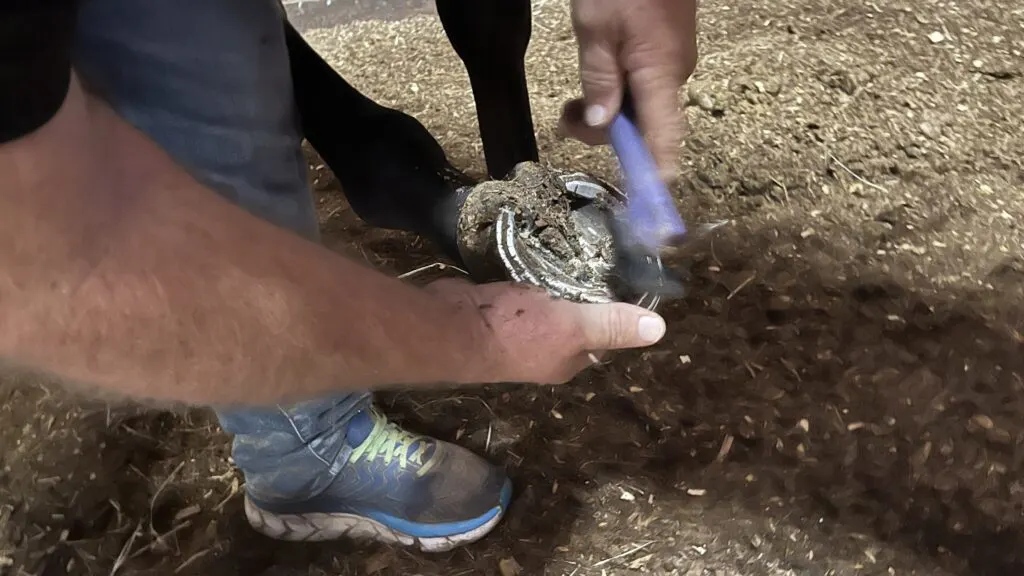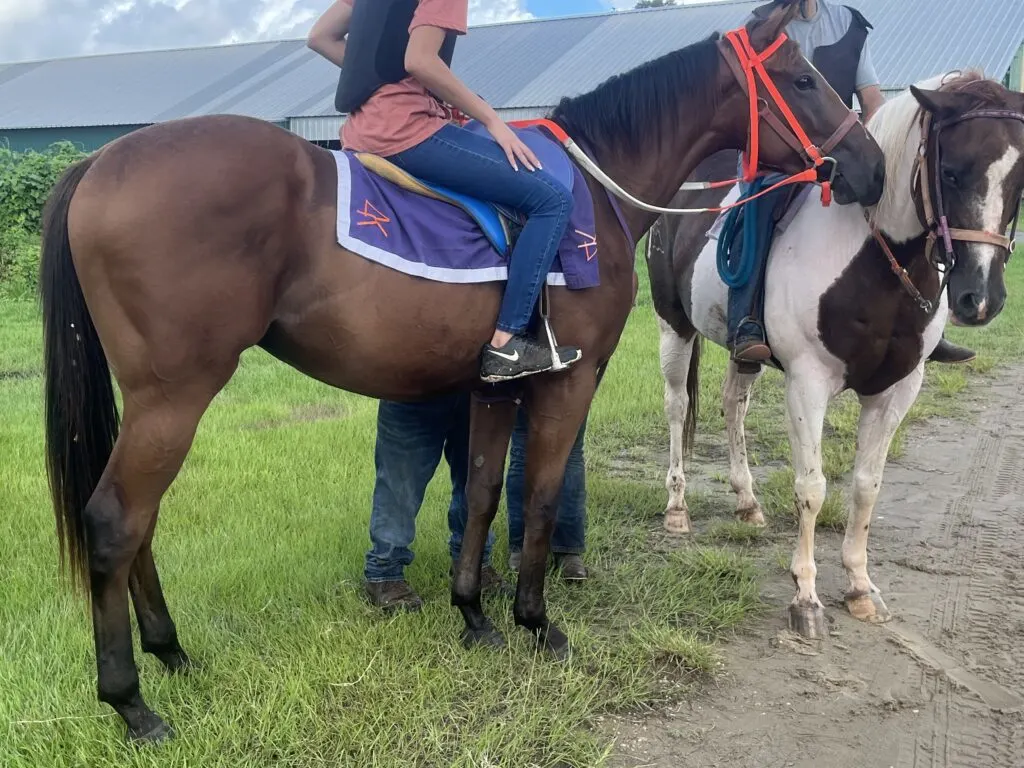Last updated: June 21, 2023
Any links on this page that lead to products on Amazon are affiliate links and I earn a commission if you make a purchase. Thanks in advance – I really appreciate it!
No one knows your horse like you do. From their steady walk to their lively gallop, you’re in tune with every rhythm of their stride. But what happens when that rhythm falters, and a limp unexpectedly alters their movement?
I experienced this with my horse; he began limping after working. Even after two vet visits, we couldn’t find a cause. It was only after I looked deeper and ruled out other issues that I discovered soft soles were the problem. It taught me how complex and varied horse limping can be.
In “Decoding Your Horse’s Limp: Step-by-Step Evaluation,” we’ll talk about the many reasons for horse limping and guide you on how to examine your horse’s health. Let’s learn together to ensure our horses stay healthy and happy.

Understanding Horse Limping
Understanding the subtle language of your horse’s movement is essential to their health and well-being. Sometimes, this language includes an irregularity, or a limp, signaling a potential problem that needs your attention.
Limping in horses can manifest in different ways. It might be a slight bobbing of their head, a shortened stride, or hesitancy to put weight on a particular leg. Signs could be subtle, like I experienced while riding my horse. I noticed something was a bit off in the rhythm, a change that became pronounced once we stopped riding and I led him by hand; it was particularly pronounced when I turned him to one side.
These signs, subtle or obvious, are valuable clues pointing toward the possible reasons for limping. Causes can range from a straightforward stone bruise to more complex issues like tendon injuries. Other potential reasons include arthritis, abscesses, joint infections, and even severe bone conditions. Each of these causes can influence your horse’s movements in unique ways and present distinct signs.
Recognizing these signs and understanding what they mean for each potential cause is your first line of defense in maintaining your horse’s health. Your attention to nuances, and knowledge of your horse’s natural stride, whether you’re in the saddle or leading them by hand, is crucial in spotting and decoding these signs early on.

Step-by-Step Evaluation
Identifying a potential issue in your horse starts with a thorough evaluation. Here’s a step-by-step guide to walk you through the process of assessing your horse for lameness.
Step 1: Observation
Start by watching your horse when they’re at rest and when they’re in motion. Look for any changes in posture or behavior. Is your horse shifting their weight from one foot to another more than usual? When they move, do they favor one leg or show hesitation during certain movements?
Remember my own experience – a subtle inconsistency while riding turned into a noticeable limp when my horse turned. Initially, the way my horse moved led me to suspect a shoulder injury.
Step 2: Physical Check
Next, perform a hands-on check. Run your hands along your horse’s legs, feeling for any heat, swelling, or tenderness. Be gentle but thorough. Your horse’s reaction might give you clues about any discomfort.
Step 3: The Hoof Test
The hoof test is crucial to rule out foot-related issues like stone bruises or soft soles. Using hoof testers, apply pressure on different areas of the hoof. Watch your horse’s reaction carefully – if they pull away or show discomfort, it might indicate a problem. During our first round of testing, my horse failed to reveal his injury.
Step 4: Palpation and Flexion Tests
Palpating involves feeling the tendons and ligaments in the horse’s leg and looking for any abnormalities. The flexion test, on the other hand, involves bending the horse’s joint and then asking them to move off quickly.
When I suspected a shoulder issue in my horse, it was the flexion test that helped me rule it out. Any lameness that appears after a flexion test could signal joint or soft tissue issues. Remember, these steps provide a starting point for evaluating your horse.
After going through these steps, I felt confident the problem was in my horse’s foot. I just wasn’t certain if it was a stone bruise, a deep abscess, or soft soles. I decided to address his soles first and work from there.
If your horse is showing signs of discomfort or if you’re unsure about anything, always consult with a professional. You know your horse best, and your observations are invaluable in ensuring their health and well-being.

When to Seek Professional Help
As a horse owner, your keen observations are invaluable in spotting early signs of trouble; it’s equally crucial to know when it’s time to call in a professional. There are instances where a trained vet’s expertise becomes indispensable in diagnosing and treating lameness.
So, when should you call a vet?
A good rule of thumb is if your horse’s lameness persists or worsens over a couple of days or if they’re in obvious discomfort, it’s time to seek professional help. Likewise, if you’ve carried out the step-by-step evaluation and you’re still uncertain about what’s causing the limp, it’s better to have a vet examine your horse.
Your vet’s role is not only to diagnose the exact cause of the lameness but also to formulate an appropriate treatment plan. They have specialized tools and knowledge to conduct a thorough examination. This might include diagnostic imaging like X-rays or ultrasounds, which can reveal issues not visible on the surface.
In my case, even after two vet checks, it took a process of elimination and close observation to figure out my horse’s limping was due to soft soles. This highlights the complexity of lameness issues and the importance of a vet’s role in solving such puzzles.
Remember, while your vigilance plays a crucial role in early detection, timely professional intervention is equally essential in ensuring your horse’s health and comfort. Trust your instincts, and don’t hesitate to seek help when it’s needed.
Preventive Measures
Prevention is always better than cure, and in the case of horse lameness, there are several proactive steps you can take to minimize the risk. Here are some tips and practices to help keep your horse in their best stride:
Regular Exercise: Consistent, balanced exercise helps to build strong muscles, tendons, and ligaments, reducing the risk of injury. Remember, though, moderation is key – overworking your horse can lead to fatigue and stress injuries.
Proper Hoof Care: Good hoof care is paramount for a horse’s well-being. Regular hoof cleaning, trimming, and proper shoeing can prevent many hoof-related issues, such as stone bruises or soft soles. In my experience, applying turpentine and using sole pads were effective in managing my horse’s soft soles.
Good Nutrition: A well-balanced diet ensures your horse has the necessary nutrients to maintain healthy bones and tissues. Consult with a vet or equine nutritionist to ensure your horse’s diet meets their needs.
Appropriate Terrain: Be mindful of the terrain where your horse walks, trots, and gallops. Uneven or rocky surfaces can lead to injuries. If possible, try to provide a variety of surfaces for them to move on to develop good foot balance and strength.
Regular Vet Checks: Regular health check-ups with a vet can help identify and address potential issues before they become significant problems.
Listen to Your Horse: No one knows your horse like you do. If they seem off, trust your instincts. As I’ve experienced, sometimes the subtlest signs can be indicators of a bigger issue. Be observant, be proactive, and you’ll be well on your way to keeping your horse in their best form.
Here is a Youtube video about a Morgan horse with a front leg limp.
Conclusion
The journey of understanding and addressing your horse’s limp can be intricate and often requires a keen eye for detail. From observation to evaluation, every step is a testament to your deep bond with your horse and your commitment to their well-being.
While each horse is unique, presenting their own set of signs and symptoms, knowing the basics of lameness and having a systematic approach can make a world of difference. Remember my story: subtle changes in gait, thorough evaluations, and even personal discoveries about soft soles.
Remember to involve professionals when needed and employ preventive measures to ensure your horse’s continued health. Your role as a caregiver is not just about recognizing and addressing issues but also about preventing them.
Keep in mind; no one knows your horse better than you do. Your observations, coupled with professional help and guidance, are the key to decoding the mystery behind your horse’s limping.
Note: The health of an animal should always be evaluated by a professional. This guide can help horse owners to understand when there might be an issue, but it should never replace professional medical advice.
FAQs
Does a lame horse have to be put down?
No, a lame horse does not necessarily have to be put down. The appropriate course of action depends on the cause and severity of the lameness. Many conditions can be treated or managed effectively, allowing the horse to lead a comfortable life.
Why is my horse limping on his front leg but has no swelling?
A horse may limp without swelling for several reasons, mild soft tissue damage, hoof issues like bruising or soft soles, or a subtle fracture. The absence of swelling doesn’t rule out injury or discomfort. Any persistent limping should be evaluated by a vet to identify the exact cause and appropriate treatment.
